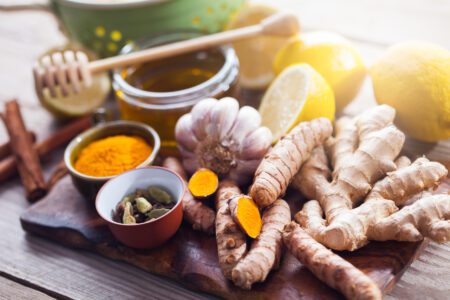Versatile, fuzzy mullein is a gardener’s friend, an herbalist’s delight and an engineering marvel all on its own. A member of the snapdragon family, mullein has flowers that are flat and open, unlike the irregular “dragon faces” of snapdragons. Within the Scrophulariaceae family, the genus Verbascum consists of about 300 species native to Europe, West and Central Asia, and North Africa. Most are tall, stout biennials with large leaves and flowers in long terminal spikes. The species best-known among herbalists is the homely but useful common mullein, V. thapsus.
First-year plants form a rosette of large, velvety leaves up to 1 foot long. In the second year, a velvety flower spike grows to 8 feet tall. The stalk has alternate leaves that clasp the stem, a nifty arrangement that directs rainwater down the stem to the roots. From June to September, five-petaled yellow flowers 1/4 to 1 inch across bloom randomly in the dense, club-shaped terminal cluster. The three upper stamens, which are short and woolly, contain a sap that lures insects to the plant. The two lower stamens, which are longer and smooth, produce the pollen that fertilizes the flower.
Several mullein species with more attractive leaves or flowers are prized garden ornamentals. These include the moth mullein (V. blattaria), with light pink to white flowers; Olympic (or Greek) mullein (V. olympicum), with 8-foot branching stalks and golden yellow flowers; purple mullein (V. phoeniceum), a 3-foot perennial with long-blooming flowers; and nettle-leaf mullein (V. chaixii), with purple-centered yellow or white long-blooming flowers. Many beautiful and showy hybrids also have been developed.
Also Known As
The name mullein probably comes from the Latin word mollis, meaning soft, referring to the plant’s woolly stem and leaves. The name also might relate to the Latin malandrium, meaning malanders, a cattle disease for which mullein was used as a remedy.
A couple of folk names for mullein have more intriguing associations. “Candlewick plant” refers to the old practice of using the dried down of mullein leaves and stems to make lamp wicks. Some say mullein stems once were dipped in tallow to make torches either used by witches or used to repel them, hence the name “hag taper.” The custom of using mullein for torches dates back at least to Roman times.
“Jacob’s staff,” “Jupiter’s staff” and “Aaron’s rod” all have been used as names for the tall flower stalks. The plant’s soft leaves also are known commonly as “bunny’s ears” and “flannel leaf.
Traditional and Modern Uses
Mullein tea is a traditional treatment for respiratory problems, such as chest colds, bronchitis and asthma. Mullein leaf tea is slightly bitter; a tea of the flowers is sweeter. Both the leaves and flowers contain mucilage, which is soothing to irritated membranes, and saponins, which make coughs more productive. Research has shown that the herb has strong anti-inflammatory activity, and lab studies suggest that mullein flower infusions have antiviral properties, as well.
Many of mullein’s traditional medicinal uses were similar throughout the Old and New World, but whether European settlers learned to use the herb from Native Americans or vice versa is open to debate. Besides using mullein leaf and flower teas to treat respiratory problems, some Native Americans also used the plant’s roots. The Creek Indians drank a decoction of the roots for coughs; other tribes smoked the roots or dried leaves to treat asthma.
Topical applications were equally varied. The Cherokee rubbed mullein leaves in their armpits to treat “prickly rash.” Leaf poultices were used to treat bruises, tumors, rheumatic pains and hemorrhoids. Mullein flower oil (made by steeping the flowers in warm olive oil) also has been used for treating hemorrhoids, as well as earaches.
Mullein leaves have been used in cosmetic preparations to soften skin. “Quaker rouge” refers to the practice of reddening cheeks by rubbing them with a mullein leaf. And a yellow dye extracted from the flowers has been used since Roman times as a hair rinse as well as to dye cloth.
Like many other herbs, mullein is not entirely benign. Some people find the plant’s hairs irritating to skin and mucous membranes. It’s a good idea to see how you react to a small amount of mullein before consuming it or smearing it on your body. And always strain the tea through fine-weave cloth or a coffee filter to remove any stray hairs.
How to Grow Mullein
Mullein is drought-resistant and grows easily from seed. Sow a small pinch of seeds about 18 inches apart and 1/16 inch deep in ordinary, well-drained soil, toward the back of the border or bed. A location in full sun is preferable, but mullein will grow in light shade. Clumps of seedlings and low rosettes will arise the first year. By the second year, the mature plants will provide a tall vertical element in the garden. Mullein self-sows readily, so take care to pull out unwanted plants to keep your mullein patch tidy.
Where to Buy Mullein
• Mountain Rose Herbs (oil, leaves, flowers, seeds)
(800) 879-3337
www.mountainroseherbs.com
• Mountain Valley Growers (plants)
(559) 338-2775
www.mountainvalleygrowers.com
• Richters (seeds, leaves, flowers, extracts)
(905) 640-6677
www.richters.com








